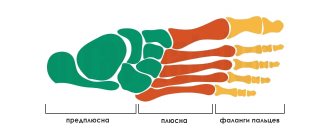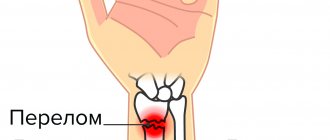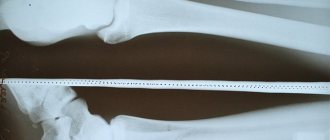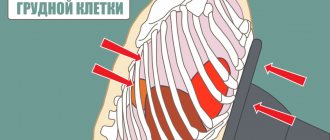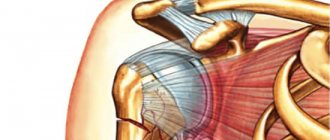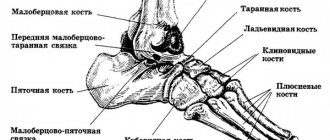Publication date: September 18, 2020
A broken big toe is a fairly common injury that a person can get while playing sports, at work, while walking, and even at home. Pain sensations differ from the severity of the injury and its size. For example, if we are talking about a fracture of only one nail phalanx, then it is quite easy to miss it or even confuse it with a regular bruise. And it is precisely because of the latter that a slight fracture can lead to quite serious consequences and improper healing. We strongly recommend that after a strong blow or injury, you can contact a medical center to rule out a fracture or begin its immediate treatment.
Signs of a broken toe
Depending on the location and severity of the fracture, symptoms can vary greatly. When a phalanx is cracked, pain is practically not felt, and the victim may not even be aware of the problem; very often the bone heals without plaster or fixation. When the first phalanx of a finger is fractured, severe, aching pain is felt.
When a toe is broken, the general symptoms are as follows:
- a hematoma forms at the fracture site;
- possible hemorrhage;
- the skin becomes dark blue, the skin around the damaged bone swells;
- severe and sharp pain with any attempt to touch or move a finger;
- unnatural mobility of the injured finger;
- inability to lean on the affected leg;
- immobility or partially limited movement of the finger;
- increased temperature and redness at the site;
- with a comminuted fracture, shortening of the finger is possible;
- with an open fracture, a wound with bone fragments;
- pronounced twitching or pulsating of the finger.
Upon physical examination, crunching of bone fragments is observed if little time has passed since the injury. The crunch is the result of the friction of broken bones against each other. Finger fractures are combined with damage to the ligamentous apparatus, sprains and dislocations of the phalangeal joints.
Sprain or fracture, how to determine
A sprain is a ligament injury characterized by tearing of the fibers. Most often, ligaments are damaged in the area of the middle joints of the limbs. This injury is characterized by a clear clinical picture consisting of the following symptoms:
- pain syndrome, the severity of which depends on the severity of the injury. The pain can be so intense that it leads to traumatic shock and loss of consciousness;
- swelling and hematoma. The intensity depends on the severity of vascular damage. Thus, with severe damage to the ankle ligaments, the leg can sometimes more than double in volume;
- loss of mobility. It may be almost complete, as in a fracture, or almost insignificant.
Important: a third-degree sprain can often be accompanied by an avulsion fracture, in which the ligaments tear off the bone and take a small fragment of it with it.
Mild sprains are easy to distinguish from a fracture and usually do not require special medical attention. More serious degrees of injury differ in the nature of the pain syndrome: pain when the ligaments are torn is acutely manifested at the moment of movement or palpation. With a fracture, it is always strong, does not weaken over time, and an acute reaction to palpation is also observed.
A good way to tell the difference between a sprain and a fracture is to apply ice to the injured area. For sprains of any severity, cold compresses help well: they reduce inflammation and muffle pain, causing numbness in the nerve endings that transmit a signal about the injury. Cold is especially useful for second- and third-degree sprains, since the inflammatory process with such injuries tends to intensify. Cold compresses should be applied for 10-15 minutes every 1-2 hours throughout the day. For a fracture, a cold compress may slightly dull the pain, but will not relieve inflammation. In addition, the pain syndrome will gradually begin to intensify.
For any sprains, if the ligaments have not been torn from the bone, the patient’s condition improves after a few days, by limiting the load on the injury site and applying compresses. If the condition does not change or worsens, you need to seek medical help and take an x-ray to confirm the diagnosis: most likely, it has a fracture, crack, or the ligaments have been torn from the bone.
How can you distinguish a possible bruise from a fracture?
A bruise or fracture can be determined by several parameters:
- Features of the pain syndrome.
- Finger movement.
- Skin color at the site of swelling (bruise).
- Presence of hemorrhage.
- Phalanx shape.
The clinical picture of a bruised finger is as follows:
- The victim experiences sharp pain, which begins to subside over time. The nature of the pain is “aching.” Using a cold compress can speed up the process of relieving pain symptoms.
- When bruised, the finger is not deformed. Immediately after a bruise, all movements are accompanied by sharp pain (pulsation is possible); as the pain subsides, the motor activity of the finger is gradually restored.
- Depending on the nature of the bruise, the color of the skin at the site of the injury may be dark red, pink, or pale pink. Swelling may appear immediately, after a day, or not appear at all. The blood at the site of the injury spreads diffusely (scattered), a bruise may appear.
General and distinctive features of various types of finger injuries
Before distinguishing a severe bruise from a broken finger, it is worth paying attention to the general symptomatic manifestations that are characteristic of all possible types of finger injuries.
In this case we are talking about:
- severe painful sensations;
- feeling of heaviness of movement;
- localized redness at the site of the blow received.
Characteristics of a damaged finger
In order to understand how to distinguish a finger bruise from a fracture, you should pay attention to the fact that a fracture is a violation of the integral structure of bone tissue or periosteum.
At the same time, a bruise is defined in modern medicine as a relative injury to soft tissues that are localized in the area of the struck finger (this can include skin tissue, subcutaneous tissue and muscles). Thus, the main distinguishing feature is related to the visibility of the violation that has occurred: from the visual side, the integrity of both the skin and the phalangeal bone itself remains normal.
It should be noted that fractures are found to be marginal, transversely serrated, helical without the presence of displaced fragments, and also open. Naturally, the task of distinguishing a bruised toe from a fracture becomes more difficult, since most often a closed fracture can be mistaken for a bruise, when fragments of the damaged bone remain undisplaced.
Main characteristics for distinguishing a bruise from a violation of the integrity of the phalangeal bone
Speaking about the pronounced symptoms of impaired integrity of the bone of the leg or arm in the area of the struck finger, it must be emphasized that it is distinguished by the presence of:
- intense pain that does not subside not only immediately after the blow, but also after several hours;
- constant increasing swelling and the formation of pronounced bruises (hematomas), although in isolated cases swelling may be completely absent;
- increased pain when trying to move the injured limb;
- in the presence of displaced bone elements, the damaged finger remains in a deformed state (shortened or elongated), which indicates a fracture has occurred;
- pathological mobility and crepitus, which make it possible to understand how to identify a fracture or bruise of a toe, increasing the risk of damage to neighboring vessels and nerves;
- bleeding, which is typical for open types of broken bone integrity;
- the presence of a symptom of axial load, when when knocking on places above the injury, the pain in the area of the blow received increases significantly.
Formation of hematomas as the main symptom of a finger bruise
In order to learn how to identify a bruise or fracture of a finger, it is necessary to take into account the characteristic features of the bruise, which are not too numerous.
In this case it is:
- Pain that becomes less severe a few hours after the blow is received.
- Swelling, which has the ability to increase, but can decrease with an elevated position of the limb.
- Impaired mobility of joints adjacent to the site of impact, which is caused by swelling and pain.
Basically, the diagnosis of the injury consists of studying the symptomatic characteristics and subsequent X-ray examination. Despite this, even without X-ray confirmation, a doctor, as well as a non-specialist in this field, is able to establish a preliminary diagnosis.
Thanks to the following table, you can accurately understand the difference between a broken finger and a bruise:
| Symptom | How it manifests itself in the case of a fracture and bruise, general and distinctive features |
| Soreness | A fracture is characterized by intense pain. It cannot subside with time or lack of movement. Palpation only provokes increased pain.
|
| Swelling | In most cases, the localization of the impact begins to swell within a few days, which is one of the main reasons for the patient’s delay in seeking qualified medical help.
As for bruises, the main difference between a fracture and a bruised toe is the immediate formation of significant swelling in the area of impact. At the same time, it can completely disappear or decrease within twelve hours after the time of injury. |
| Deformation | Irregular shape or position of the injured finger is one of the most striking symptoms of impaired integrity. Due to deformation, the finger becomes visually shortened or elongated, so comparing it with a normal finger makes it possible to determine whether we are talking about a fracture or a bruise.
As for the bruise, the size of the injured finger remains within the normal range, not taking into account the swelling of the area of the blow received. |
| Mobility | The ability to move the injured foot is one of the main factors that differentiates a bruised toe from a fracture. If in case of a fracture it is difficult for a person to move and get to the hospital independently, then in case of a bruise the ability to move normally is retained.
|
Thus, in order to first determine the type of injury to a toe or hand, it is necessary to pay attention to the nature of the pain, the presence of swelling, localized bruising, as well as the ability of the victim to move the injured upper or lower limb.
Despite this, only a qualified specialist can accurately determine the nature of the damage that has occurred. Currently, this can be done using various additional diagnostic methods, among which radiography and computed tomography are most often used.
The use of these diagnostic procedures provides the opportunity to study all the anatomical features of the resulting injury (presence of injured neighboring vessels and tissues, displaced fragments of the phalanx bone of the struck finger).
How to diagnose a broken finger
- Upon palpation, the pain sharply intensifies and does not go away for a long time (an hour or two).
- When a fracture occurs, a sharp pain is felt, which can radiate to the nearest parts of the foot. Deformation of the phalanx, unnatural position of the finger. Swelling and strong (acute) pulsation at the fracture site.
- If there is a fracture, the victim cannot move the injured finger. Any attempt to stand on the affected leg causes the patient to experience severe pain. To relieve pain symptoms, the affected finger is fixed in one position.
- Hemorrhages form under the nail, hematoma and swelling appear, and the skin becomes bluish.
How does a fracture differ from a crack?
This type of injury has practically no specific signs or differences, so it is very difficult to determine it without the help of a doctor - they are often confused with bruises and fractures. The difference is that when a crack occurs, bone tissue is damaged, but it does not form fragments and does not move away from its main part. The crack can manifest itself in the form of noticeable swelling and pain when trying to move, which over time not only does not subside, but also intensifies.
Bone tissue injury occurs due to external mechanical influence, for example, a blow or a fall, while its strength is inferior to the load force. You can understand whether it is a fracture or a crack by whether the supporting function of the bone is preserved: if there is a crack in the limb, it will still be possible to lean on it, but if there is a fracture, it will not.
When a crack occurs, severe pain occurs, which intensifies with any movement or attempt to palpate the site of injury. At rest, it may be muffled, dull, tingling or pulsating. It appears due to damage to the periosteum, which contains many receptors that signal that the bone is broken.
The second symptom is swelling in the area of injury. Most often, it gradually increases, but can go away within a day with first aid. Restricted mobility, bruising and hematomas are also observed, but may be less pronounced than with a fracture.
Important: a crack can be treated much easier and faster than a fracture. The prognosis for this injury is more favorable, and the period of rehabilitation and restoration of mobility takes less time and requires less effort.
First aid for a broken finger
If you have symptoms indicating a possible fracture, there is no need to panic in the first place. The first thing you should do is call an emergency ambulance. Before the doctor arrives, all efforts of the victim should be aimed at stopping the bleeding (in the case of an open fracture), fixing the limb and anesthetizing the injury site. To prevent negative consequences, the following rules must be followed:
- even in the absence of pronounced symptoms, one should not refuse to consult a doctor;
- fixation of the limb is one of the main stages of effective treatment;
- the broken finger should not touch foreign objects;
- non-displaced fractures may not be fixed until the ambulance arrives;
- pain can be relieved with nimesil, analgin and ibuprofen;
- A cold compress is another effective way to relieve pain.
It is important to note that when applying an ice pack, keep the compress for no more than 10 minutes to prevent possible frostbite. A repeat procedure is possible after a 3-4 minute break. Even if you suspect a fracture, experts recommend immediately contacting a specialized medical institution for qualified help.
Causes of injury
There is a basic list of conditions under which a person can suffer traumatic injury in the home, as well as outside it. Such conditions include:
- Intense blow of a finger on a hard object;
- A fall from a height resulting in a finger hitting a hard object or hard surface;
- Hitting a hard surface or hard object while walking or running.
In addition, a person can get a bruise or fracture of this structure during a fight, as well as during active sports (football, wrestling, cycling, roller skating). Most often, the first toe, as well as the little toe, are hit. In everyday life, bruises and fractures occur when hitting furniture legs or walls.
Treatment methods for a broken finger
| Name | Description |
| Closed reduction | This method is used for closed fractures and in the absence of displacement. Antiseptic agents are applied to the damaged finger, after which the doctor uses mechanical force (pulling) to return the finger to its normal position. A significant disadvantage of this method is the need to repeat this procedure. |
| Skeletal traction | This method is used for displaced fractures. This procedure requires a metal needle, which is passed through the finger with a small load, which allows the bones to be in a normal position. At the end of the procedure, the doctor performs immobilization. |
| Public Methods | The surgeon performs osteosynthesis. Secures bone fragments with special metal elements. The broken parts of the bone are united and its correct shape is restored. Open reduction is performed for all open and comminuted closed fractures. The operation also eliminates complications that arose during the treatment. |
| Surgical intervention | The operation is indicated for patients who have an open fracture of the big toe or in case of crushed phalanx. During surgery, the doctor restores the physiological position of the finger. To fix fragments, knitting needles, plates, and screws are used. |
Which doctor should I contact?
Regardless of the results of self-diagnosis, in case of any serious injuries, you should go to the emergency room at your place of residence or to the emergency room of a hospital, where there is a surgical or, even better, trauma department, as soon as possible.
An orthopedic traumatologist treats fractures, bruises and torn ligaments, but a surgeon can also provide assistance. If this is not possible, you should consult a general practitioner, and if a child is injured, consult a pediatrician. After confirming the diagnosis with an x-ray and prescribing treatment, you can make an appointment with a nutritionist to avoid complications associated with limited mobility, as well as with a chiropractor, massage therapist, or physiotherapist.
If the injury was caused by increased fragility of the bones, you should additionally consult a rheumatologist; if the fall was due to loss of consciousness or an attack of lightheadedness, you should consult a cardiologist or neurologist.
Injury Prevention
Damage can be prevented by adhering to the following rules:
- Proper balanced nutrition, enriched with minerals and vitamins to strengthen the bone structure.
- Moderate physical activity.
- When training, use protective equipment.
- Wearing shoes according to the season.
- In winter, you should try to walk on sand-strewn paths.
- Compliance with safety rules at work and at home.
- See a doctor for help in a timely manner.
Damage to the little finger is a condition that requires accurate diagnosis to determine the nature of the injury and develop a treatment regimen. If you follow all the doctor’s recommendations, the illness will go away faster and the person will be able to return to their normal rhythm of life.
Doctors' opinion
Regardless of the type of injury you receive, be it a bruise or a fracture, qualified medical care is mandatory. An accurate diagnosis can only be made after a thorough examination and an x-ray of the injured finger. Ignoring measures to treat a fracture can lead to a number of negative consequences:
- osteomyelitis - inflammation of the bone marrow, accompanied by purulent discharge and bone destruction;
- deformation of the phalanx of the finger and improper fusion of bone tissue;
- the formation of ankylosis (a previously mobile joint is replaced by bone tissue);
- development of flexion contracture, as a result, difficulties in straightening the fingers;
- the appearance of a false joint (the finger bends in an uncharacteristic place).
Along with timely treatment of the fracture, which guarantees the patient rapid and proper healing of the bone, doctors focus on the need to engage in therapeutic exercises.
The rehabilitation course after a fracture includes a special set of exercises.
So, you can develop a finger by following these instructions:
- To enhance local blood circulation, you should rub your hands together before doing any work.
- Rotating the brushes clockwise and counterclockwise is also effective.
- It is recommended to sort out cereals, type on the keyboard, assemble puzzles or construction sets to develop fine motor skills of the fingers. You can use an expander to train your muscles.
Treatment
In order to reduce pain, creams or gels based on diclofenac, ketorolac, nimesulide or indomethacin are used. They are applied to the damaged area 2-3 times a day, according to the instructions.
For treatment, external agents are used, for example Heparin ointment.
You can reduce swelling and get rid of hematoma using drugs based on heparin, troxerutin or horse chestnut. They improve blood circulation in the area of damage, restore capillaries and reduce pain.
First aid
It is important for every person to know what to do in case of a bruise or fracture at the pre-medical stage. The first aid plan for a bruised toe includes the following items:
- Limb immobilization. It is recommended to carefully place the leg on the side of the bruise on a soft pillow or a self-made bolster made from a blanket or towel. This event will normalize blood supply in the lower limb.
- At the next stage, to relieve swelling and inflammation, you need to apply a heating pad with ice or a cold compress to the damaged area. Before applying it to an injured finger, it is recommended to wrap the heating pad with ice in cotton cloth. The duration of holding such a compress is no more than 20 minutes.
- If, as a result of a bruise, the integrity of the skin has been compromised, the resulting abrasion or wound must be treated with hydrogen peroxide. The treated finger must be bandaged with a sterile bandage or a bactericidal patch applied.
- In order to maximize immobilization of the injured toe, a tight bandage is applied to the entire foot.
- If a hematoma has formed as a result of a bruise, then an anti-inflammatory ointment should be applied to its location.
- If the integrity of the nail plate is damaged, a pressure bandage is applied to the bleeding area.
If you experience severe pain, you should take a pain reliever.
Before visiting a traumatologist, the list of emergency measures for a fracture contains the following items:
- Taking a pain reliever from the group of non-steroidal anti-inflammatory drugs;
- If there are visible skin lesions, treat them with an antiseptic (hydrogen peroxide);
- Fixing the damaged finger to a nearby one using a bandage and cotton wool, which is placed between two fingers as a softening pillow. If the finger is too deformed, then its fixation is unjustified, as this will lead to increased pain;
- The lower limb on the injured side should be placed on an elevated position, and a heating pad with ice should be applied to the injured area.
After emergency measures are taken, a person with an injury is advised to immediately go to the emergency room.
General symptoms
The clinical manifestations of a bruised injury in the toe area have been described in detail above. A fracture of the bone elements of a given anatomical formation can be recognized by the following characteristic signs:
- Limited or absent mobility in the area of the injured finger;
- Intense pain syndrome, aggravated by touching and attempts to move;
- Anatomically unacceptable position of the injured finger. The injured structure occupies a forced position taken during the injury;
- Local increase in skin temperature over the injured area;
- Redness and severe swelling of the skin in the fracture area.
In addition, the formation of a hematoma of the damaged toe due to a fracture or bruise is observed.
Complications
A fracture of the little toe is not as safe as it might seem at first glance. It, like other illnesses, can lead to dangerous consequences in a person. These complications:
- Callus formation. It is formed when bone fragments fuse incorrectly and the body loses its former strength. It interferes with normal development of the damaged finger.
- Formation of a false joint. Such joints block bone canals, bones, and lead to friction of supporting surfaces. Typically, such a joint is formed instead of cartilage. In this case, the finger acquires an unnatural position and an inflammatory process develops in it.
- Development of ankylosis. The spread of the inflammatory process inside the finger leads to ossification of the internal cartilage, connection of the phalanges of the fingers and the formation of solid bone. Joint prosthetics helps to partially get rid of ankylosis, but usually it remains and patients suffer from this disease all their lives.
- Incorrect fusion of bones. This usually occurs when the bone remains are incorrectly repositioned. This also leads to the formation of callus, bone deformation, and impaired support function. Doctors can remove the callus and re-operate to connect the bone fragments.
- Development of osteomyelitis. Its development is caused by the spread of the inflammatory process in the bone marrow. Inflammation is caused by pathogenic bacteria that enter the blood. Therefore, with an open fracture, pathogenic bacteria should not be allowed to enter the wound. If this happens, the wound must be treated with an antiseptic.
- The development of gangrene, in which tissue dies. This occurs due to strong squeezing of the fingers. Oxygen begins to flow into them worse, tissue cells begin to die. Moreover, if pathogenic bacteria enter dead cells, an inflammatory process develops in the body. Remember that gangrene constantly spreads to neighboring areas of the skin, so a person cannot do without surgery.
The essence of trauma
Any bone in the human body can break. But the bones of the foot, especially the toes, are especially susceptible to fractures. Such injuries occur due to awkward movement, a fall or a strong blow. There are open or closed fractures. When open, the signs of damage are so obvious that it is immediately clear to everyone that the finger is broken. A closed fracture is difficult to distinguish from a dislocation, sprain or bruise. After all, there are no external injuries, and the pain is often not very severe.
A fracture is a violation of the integrity of a bone. It may crack or completely separate into several parts, or a piece may break off from it. Toes are often damaged in this way, especially when playing sports or walking barefoot. You can break a finger by hitting your bare foot on a corner of furniture, on a stone on the street, or by twisting your foot due to uncomfortable shoes or ice.
The little toe is especially susceptible to this type of injury. This is due to the fact that his bones are very thin and his musculo-ligamentous apparatus is weak. This injury is usually quite painful. But sometimes the victim may not feel pain. Such damage does not greatly affect the ability to move. An uncomplicated fracture of the little finger can heal without a cast, and not all victims with such an injury consult a doctor.
The thumb is also often injured. Its fracture is dangerous because it performs a supporting function. It is larger than all the other toes, and its fracture is always accompanied by severe pain, swelling, often spreading to the entire foot, and hematoma. Improper treatment of such an injury can lead to arthrosis, the development of flat feet, and foot deformities, which will subsequently cause serious problems when walking.
IMPORTANT: Any broken toe requires medical attention. This will help avoid inconvenience in the future. After all, if it does not heal properly, it can lead to serious problems in movement and in choosing shoes, constant pain in the foot, and the development of arthritis or arthrosis.
Diagnostics
Initially, a patient with a broken little finger is referred for an X-ray examination. It is in the image that bone fragments will be visible, which indicate the presence of a fracture in a person. Sometimes the patient is sent for a computed tomography scan. It helps determine the nature and complexity of the damage. After the examination, the doctor can make a diagnosis, prescribe the correct treatment and tell you whether it is possible to break the little toe.
In children
Children can also break their little toe. In a small child or in children in general, a fracture of the little toe is characterized by the fact that one piece of bone tissue enters another. They develop a so-called “angular displacement”. But due to the rapid growth of bone tissue, when the little toe is broken, the bones heal faster and the bone fragments fall into place on their own. But a traumatologist will be able to answer whether children should be given a plaster cast if their little toe is broken.
In adults
Also, an adult who hit his foot on a heavy object can independently understand how to recognize a fracture of the little toe. He needs to do the following:
- Step on a limb. The broken finger does not participate in walking; it bears little weight. But it is precisely because of the weight that the little finger is deformed, and the patient immediately sees that it is broken. Remember: you shouldn’t feel the sore spot yourself. This can cause the bones to shift a second time.
- Place two limbs side by side and look at them. If it is externally noticeable that they are different, then the patient should immobilize the injured limb and seek help from a doctor.
- Look at the broken limb. If the phalanges are different, a crunching sound is heard when moving a finger, then the foot should also be immobilized. You cannot wear shoes on her, because... this can cause sharp pain.
If the patient discovers a fracture, he must be taken to a medical facility. Only medical professionals will be able to answer his question about how to quickly treat and what to do if his little toe is broken.
Causes
Elderly people are more susceptible to this phenomenon than others. As they age, their bone structure changes and their bones become more fragile.
But a young man can also break his little finger. The reasons for this phenomenon are different:
- diseases localized in the lower extremities. They are the ones who reduce the strength of bone tissue;
- outdoor games. During games, a person can easily twist his leg and break a finger;
- hitting a heavy object. For example, a blow to the little toe on furniture, after which the first signs of a fracture appear;
- falling a heavy object on your leg.
In addition, a fracture of the little finger can occur during a stampede. When another person steps on a person's foot.
Classification
Doctors conventionally classify little finger fractures into 2 types. They are:
- with offset;
- without displacement.
Let's look at each of them in more detail, and based on the symptoms described, we will decide how to understand that the little toe is broken.
No offset
When the little finger is injured without displacement, the patient only suffers a cracked bone. The axis remains in place, the little finger does not become shorter. If a patient wonders whether it is necessary to wear a cast if the little toe is fractured without displacement, then only a traumatologist can answer it. Also, if a person has a lot of unanswered questions, he can find answers on special forums that are available on the Internet. It is there that the victim can read about whether the little toe is broken, whether a cast is applied, and what patients who have broken their fingers on the lower extremities say when applying it.
With offset
When the little toe is fractured with displacement, it is the large bone tissue that is damaged. It cracks, bone fragments change their position. In this case, the bones become deformed, and the broken little toe becomes shorter. If the patient is interested in the question of whether plaster is applied to the little toe in this case, then the answer is yes.

